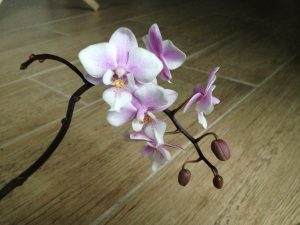My First (Successful) Orchid!
Views: 6347

I finally did it. I got an orchid to bloom before I killed it!
It’s not that I am planning on killing it when it is done blooming or that I have killed a lot of orchid plants in the past, but I have killed the only two orchids I have ever owned. This poor track record has planted the idea in my head that orchids are difficult plants to care for. This is a ridiculous misconception on my part. Not only because orchids are pretty easy plants to keep alive. But also because of the way in which both of my orchids died was pretty much out of my control.
The first died when it froze during an overnight stop on my move back from Oregon to Indiana. I could have prevented this if I weren’t too lazy to lug my twenty or so houseplants from the truck into the hotel room.
That was the Plant Massacre of 2006. The second died in the Plant Massacre of 2013 when most of my plants were suffocated by heavy soot after a house fire. So at least that time was really not my fault.
The right conditions for orchids
Anyways, outside of freezing temperatures and soot-filled air, orchids are really not that fussy about conditions. They’re a fun plant to try and grow. When I saw a pathetic looking orchid for only three dollars on the clearance shelf at a big box store, I scooped it up and brought it home. Third time’s a charm, right? It was crammed into a little two-inch pot with no drainage holes. So I also purchased a small pot made specifically for orchids that has plenty of holes for drainage and air circulation around the root zone. I repotted it using regular potting soil with a little peat moss on top. I then placed it on a bright east-facing windowsill, and have watered it lightly once a week.
Apparently this is the recipe for success. I noticed a stem emerging from the leaves around Thanksgiving. It had three blooms fully open by Christmas!
Varieties
Of course the problem with buying a tiny orchid from the clearance shelf at a big box store is that it wasn’t labelled properly. I am 99.9% certain that it belongs to the genus Phalaenopsis, or moth orchid. This is probably the most readily available orchid in stores. After that, I am about 75% certain that it belongs to the species schilleriana, but I have no ideas which of the many cultivars or hybrids it is that have been developed within that species. The whole orchid family, Orchidaceae, is one of the largest in plant taxonomy. It competes only with Asteraceae.
Diversity
The most diversity in the orchid family is found in tropical climates. However, they can be found growing almost everywhere on the planet, with the exception of glaciers. There are more than 27,000 known orchid species that belong to around 880 genera (plural for genus). Add to that the hundred thousand or so cultivars and hybrids that plant breeders have developed and the number of orchids in existence really becomes mind-boggling! (Funny etymology fact: The name orchid is derived from the Greek word orkhis which means testicle. The word Phalaenopsis breaks down into two Greek words phalaina. This means moth, and opsis, which means appearance. So technically a Phalaenopsis orchid could be called moth testicles or moth balls.)
Regardless of the humorous name, do not shy away from these beautiful plants. With a little care, they should bloom at least once, if not twice per year. Since Christmas, several more buds have opened and a secondary stem has branched from the main stem with tiny buds that will hopefully mature later and extend the bloom time to two or more months. Rather than cutting the stem near the base when it is done blooming, I think I will try cutting it just above a node to see if I can get it to rebloom on the same stem, extending the bloom time even further.
This is all very exciting, my first successful orchid!
Meet Abbi Hayes
Abbi's Recent Posts

Kalanchoe delagoensis: Mother of Millions







